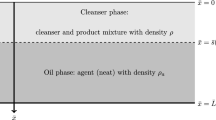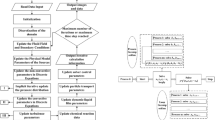Abstract
In this article, the latest developments for designing hydrogen peroxide decontamination systems are analyzed. Specifically, focus is given to the accurate calculation of hydrogen peroxide condensation phenomena and discussion of a new correlation for its accurate prediction. A procedure for calculating the condensate composition or the dew point out of this correlation is detailed, and an h–x diagram for moist, hydrogen peroxide-laden air, which is of fundamental importance for the rational design of hydrogen peroxide decontamination systems, is proposed. Also presented are theoretical results that illustrate the effect of condensation and evaporation in these systems. Finally, some perspectives for improving hydrogen peroxide systems, and the role computational fluid dynamics (CFD) may have in this field, are provided.





Similar content being viewed by others
Abbreviations
- A DHP :
-
Total inner surface area of the DHP chamber [m²]
- B j :
-
Parameters of the Redlich–Kister equation [J/kmol]
- c i :
-
Concentration of species i in the gas phase [mg/l]
- c i sat :
-
Saturation concentration of species i over the liquid film [mg/l]
- c p,i :
-
Heat capacity of species i in the gas phase [kJ/kmol.K]
- c p,chamber :
-
Heat capacity of the chamber wall material [kJ/kg.K]
- C :
-
Dimensionless concentration of inlet gas
- C μ , C 1ε , C 2ε :
-
Constants for the turbulence model
- D i :
-
Diffusion coefficient of species i in air [m2/s]
- f :
-
Target function for the dew point iteration [Pa]
- g :
-
Gravitational acceleration [m/s2]
- h :
-
Specific enthalpy [kJ/kmol]
- h 1 + x :
-
Enthalpy [kJ/kgdry air]
- ΔH v,i :
-
Heat of vaporization of species i [kJ/kmol]
- k :
-
Turbulent kinetic energy [m2/s2]
- MW i :
-
Molecular weight of species i [g/mol]
- m chamber :
-
Mass of the DHP chamber walls [kg]
- \( \dot{N}_{{{\text{cond}},i}} \left( {c_i } \right) \) :
-
Molar condensation rate of species i [kmol/s]
- N l,i :
-
Molar amount of species i in the liquid phase [kmol]
- \( \dot{Q}_{\text{loss}} \) :
-
Heat loss [W]
- p :
-
Pressure [Pa]
- p i :
-
Vapor pressure for species i in a liquid mixture [Pa]
- p i sat :
-
Vapor pressure of pure species i [Pa]
- p tot :
-
Total pressure [Pa]
- \( \vec{R} \) :
-
Reynolds stress tensor [m2/s2]
- R :
-
Molar gas constant, 8.314472 [J/mol.K]
- R gas :
-
Gas constant for air, 287.05 [J/kg.K]
- Ra :
-
Rayleigh number
- Sc t :
-
turbulent Schmidt number
- T :
-
temperature [K]
- \( \vec{U} \) :
-
Velocity vector [m/s]
- V c :
-
Chamber volume [m3]
- \( \dot{V}_j \) :
-
Volumetric flow rate [m3/s]
- w i :
-
Mass fraction of species i
- X :
-
Absolute moisture content of the air [g/kgdry air]
- x i :
-
Molar fraction of species i in the liquid phase
- y i :
-
Molar fraction of species i in the gas phase
- Z :
-
Height level [m]
- α eff :
-
Effective energy diffusion coefficient [W/m.K]
- α :
-
Heat transfer coefficient [W/m2.K]
- β i :
-
Mass transfer coefficient [m2/s]
- ε :
-
Energy dissipation rate [m2/s3]
- φ :
-
Mass flux vector [kg/m2.s]
- γ i :
-
Activity coefficient for species i
- Γ :
-
Turbulent diffusion coefficient [kg/m.s]
- λ air :
-
Heat conductivity of air [W/m.K]
- µ t :
-
Turbulence viscosity [Pa.s]
- ρ :
-
Density [kg/m3]
- σ k , σ ε :
-
Constants for the turbulence model
References
Klapes NA, Vesley D. Vapor-phase hydrogen-peroxide as a surface decontaminant and sterilant. Appl Environ Microbiol. 1990;56:503–6.
Wang J, Toledo RT. Sporicidal properties of mixtures of hydrogen-peroxide vapor and hot air. Food Technol. 1986;40:62–7.
McAnoy AM, Sait M, Pantelidis S. Establishment of a vaporous hydrogen peroxide bio-decontamination capability. Report DSTO-TR-1994. Human Protection Performance Division DSTO. 2007.
Johnston MD, Lawson S, Otter JA. Evaluation of hydrogen peroxide vapour as a method for the decontamination of surfaces contaminated with Clostridium botulinum spores. J Microbiol Methods. 2005;60:403–11.
Rohtagi N, Schuber W, Koukol R, Foster TL, Stabekis PD. Certification of vapor phase hydrogen peroxide sterilization process for spacecraft application. Report 02ICES-57. Society of Automotive Engineers, Inc. 2001.
Heckert RA, Best M, Jordan LT, Dulac GC, Eddington DL, Sterritt WG. Efficacy of vaporized hydrogen peroxide against exotic animal viruses. Appl Environ Microbiol. 1997;63:3916–8.
Hall L, Otter JA, Chewins J, Wengenack NL. Use of hydrogen peroxide vapor for deactivation of Mycobacterium tuberculosis in a biological safety cabinet and a room. J Clin Microbiol. 2007;45:810–5.
Fischer J, Caputo RA. Barrier isolator decontamination systems. Pharm Technol 2004; Issue Nov 2004:68–82.
Hultman C, Hill A, McDonnel G. The physical chemistry of decontamination with gaseous hydrogen peroxide. Pharm Eng. 2007;27:22–32.
Watling D, Parks M. The relationship between saturated hydrogen peroxide, water vapour and temperature. Pharm Technol Eur 2004; 01-03-2004
Unger-Bimczok B, Kottke V, Hertel C, Rauschnabel J. The influence of humidity, hydrogen peroxide concentration, and condensation on the inactivation of Geobacillus stearothermophilus spores with hydrogen peroxide vapor. J Pharm Innov. 2008;3:123–33.
Watling, D. Theory and Practice of Hydrogen Peroxide Vapour. In: Pharmaceutical International. Copybook Solutions Ltd. 2007. http://www.pharmaceutical-int.com/categories/biodecontamination-using-hydrogen-peroxide-vapour/theory-and-practice-of-hydrogen-peroxide-vapour.asp
Scatchard G, Kavanagh GM, Ticknor LB. Vapor liquid equilibrium. 8. Hydrogen peroxide water mixtures. J Am Chem Soc. 1952;74:3715–20.
Schumb WC, Satterfield CN, Wentworth RL. Hydrogen peroxide. New York: Reinhold; 1955.
Manatt SL, Manatt MRR. On the analyses of mixture vapor pressure data: the hydrogen peroxide/water system and its excess thermodynamic functions—corrigendum. Chemistry. 2006;12:3695.
Manatt SL, Manatt MRR. On the analyses of mixture vapor pressure data: the hydrogen peroxide/water system and its excess thermodynamic functions. Chemistry. 2004;10:6540–57.
Liley PE, Thomson GH, Friend DG, Daubert TE, Buck E. Physical and chemical data. In: Perry RH, Green DW, Maloney JO, editors. Perry’s chemical engineers’ handbook. New York: McGraw-Hill; 1999.
Bird RB, Steward W, Lightfood EN. Transport phenomena. New York: Wiley; 2002.
Reid RC, Prausnitz JM, Poling BE. The properties of gases and liquids. 4th ed. New York: McGraw-Hill; 1987.
OpenCFD Ltd. OpenFOAM—The Open Source CFD toolbox, version 1.4. Berkshire, UK: OpenCFD Ltd.; 2007.
Sandia National Laboratories. Cubit 10.2 User Documentation. Albuquerque: Sandia Corporation; 2007.
Fox RO. Computational models for turbulent reacting flows. Cambridge: Cambridge University Press; 2003.
Corvaro F, Paroncini M. A numerical and experimental analysis on the natural convective heat transfer of a small heating strip located on the floor of a square cavity. Appl Therm Eng. 2008;28:25–35.
Acknowledgement
The authors acknowledge financial support of Ortner Cleanrooms Unlimited GmbH.
Author information
Authors and Affiliations
Corresponding author
Appendix
Appendix
In order to validate the developed solver, a comparison of numerical and experimental has been performed. Therefore, our results have been compared with the results from Corvaro and Paroncini [23]. The setup consisted of a square cavity (with height of 0.05 m and a total length of 0.41 m) with a heated strip placed on the bottom wall. In the case studied in our work, the heated strip was positioned at the center of the bottom wall. The fluid in the cavity is air and the heated strip was made of brass. The side walls of the cavity were cooled and had a constant temperature of 285.5 K. The temperature of the heated strip was 302.1 K, such that the resulting Rayleigh number was Ra = 2.02 × 105.
Figure 6 shows the temperature and velocity distribution obtained with the simulations code detailed in this work. These results agree very well qualitatively with the experimental measurements, as well as the simulation results of Corvaro and Paroncini [23]. The computed mean dimensionless heat transfer coefficient (i.e., the mean Nusselt number Nu m) averaged over the heated strip using our calculations was determined as Nu m = 6.16. From simulations reported by Corvaro and Paroncini [23], Nu m = 6.28, whereas the experimental result was Nu m = 6.45. Hence, the differences are below 5%, which is acceptable.
Rights and permissions
About this article
Cite this article
Radl, S., Ortner, S., Sungkorn, R. et al. The Engineering of Hydrogen Peroxide Decontamination Systems. J Pharm Innov 4, 51–62 (2009). https://doi.org/10.1007/s12247-009-9057-3
Received:
Accepted:
Published:
Issue Date:
DOI: https://doi.org/10.1007/s12247-009-9057-3





